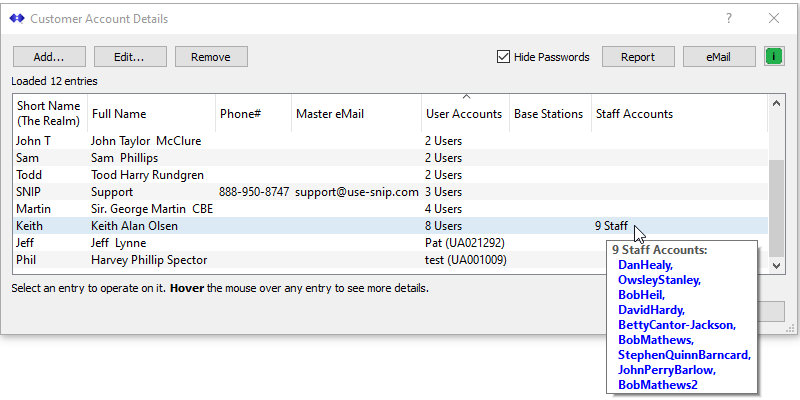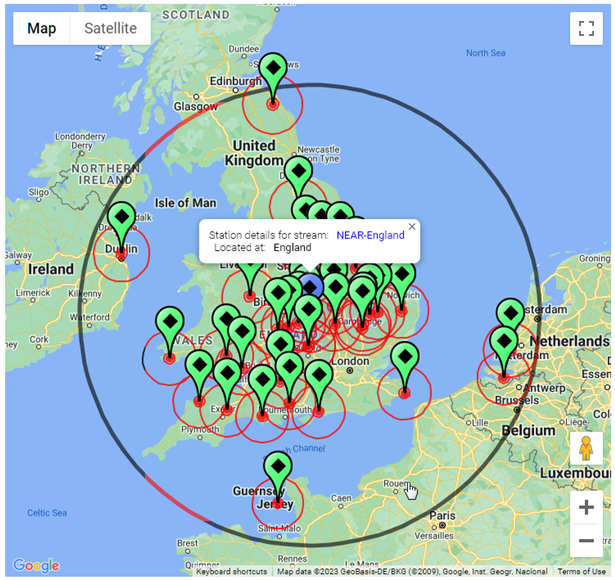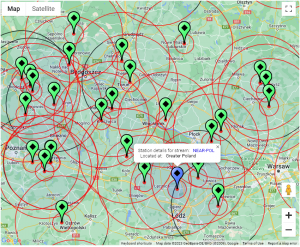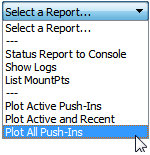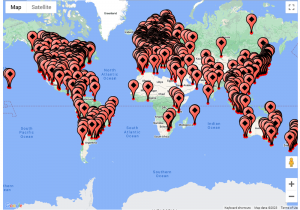What is new in the SNIP 3_11_00 release – released September 8th, 2023
(updating the prior release of 3_10 issued on June 05th, 2023)
This is the next production release of SNIP following the Rev 3_10 release. This release contains both major and minor improvements in response to user requests. This release supports both 32-bit and 64-bit installations on all Windows Platforms from Windows 7 to the current editions.
It is STRONGLY recommended that all Windows 32/64 SNIP installations now update to using this release. You will not be able to use most Google Map features until you update to this release.
Changes in this release include
Adding Staff Accounts to the Web API
In this edition of SNIP we have added support for “staff” accounts. By using Staff Accounts you can create a unique Web API account for use by any designated person to access your Caster remotely with either read-write or read-only privileges. The primary purpose of this feature is so that you can designate others to provide technical support for your user community with restricted access to the Caster. And Staff Accounts may be created for any Customer Accounts you wish give this ability to as well.
Each Staff Account has its own email (used as the account log-in) and password, and can be enabled or disabled by the Caster operator. Any defined staff accounts for the administration of the Caster are shown and edited in the Preferences Dialog. Any defined staff accounts for a Customer Account are shown in the Customer Account Dialogs and can be edited there. Details about staff accounts and the individual staff settings are also given in various dialogs and pop-up tooltips. Using the Staff account feature is entirely optional, but requires that the Web API Plug-In be present.
You can read more on using Staff Accounts in these knowledge base articles
Map Display Improvements
In this edition of SNIP we have revised the use of Goggle Maps in a number of ways. The new maps are faster, visually more pleasing, and produce less of a processing load on the Caster. If the Web API is installed, the map displays shown in Web reports are also improved. Overall coverage regions (for each specific base and for any NEAR streams) are now also displayed. These maps can be dynamically panned and zoomed and may be displayed as a full-screen image when desired. A link in the tool tips allows creating another independent Google map centered on a selected Base Station when clicked. Clicking on any icon produces a detailed tool tip for that Base, as in prior editions.
While many of the important changes are “under the hood” the overall images now also show any nearby Bases rather than just a single center point for that selected base. This provides a better sense of the resulting network coverage overlap. In the below image you can see the prior style map at left (the antenna tripod of the GNSS is clearly visible). Then, moving left to right, the new style is shown at various zooms, showing rings at 10m, 10km, and 50km as well as nearby stat ions with overlapping coverage. [Click each images for greater detail]
When looking at a Base within a network, these rings provide a sense of the relative distance to other alternative nearby base stations. Here is a similar plot of the public RTK2go coverage in center Poland.
SNIP now defaults to using these images for most plots and maps (except in the Lite models). The older style of maps are still maintained in this release with the words “old style” in the menu text but will be removed in future releases. Some of the maps also make use of the Web API Plug-In to add additional details when it is present. For example, in the STATUS report the map links in the table of entries can be just the Base Station center point, or the new style with radius rings and nearby Bases, depending on the choices set in the Preferences Dialog. Maps may also show baselines from a base to each currently connected user position and user details; but these are only available to the Caster administrator (when using the desktop or the Web API) for privacy reasons.
Other common Web API maps that show the location and the recent movement paths of each user device (NTRIP Clients) are integrated with these new maps and continue to work as before. Similarly, you can easily switch between the reports for a Base Station (plotting its location and baselines to each connected user), any connected User, and the User’s recent movement / paths.
Push-Is Base Station Streams
A newly added combo control labeled Select a Report in the Push-In tab now allows selecting a number of reports about the Push-In slots that are active, inactive, or have reservations. Three new plots of Base Stations have been added here.
The operator can request a Google Map plot with
- All the Active Push-In Base Stations, or
- All the Active and Recently Active Base Stations
(those active within the last week), or - All Push-In Base Stations with Reservations (active or not)
Here is an example plot of 6000+ the Push-In Reservations found on the public RTK2go.com Caster machine (click to enlarge).
In addition, some new logic also detects and corrects a minor problem with Rev2 NTRIP Push-In corrections seen in a few GNSS devices. By the protocol rules of NTRIP every connection request must end with an empty (blank) line. This rule more or less follows the rules of html where the empty line implies the end of the request. SNIP now detects and allows connections from devices that fail to add this final line.
Misc. Improvements
A major bug present in Rev 3.10 has been corrected. In that edition, whenever the Caster was moved to be offline, the application would crash due to a newly added background task running every 5 minutes. This has been corrected.
Improved NEAR stream tooltip logic produces better details for several type of NEAR streams.
Logic to allow the Caster operator to add their own Google Map API key has been streamlined.
We have added additional logic to exclude selected IPs from the quick ban and auto ban logic never allowing those IPs to be blocked. This was needed due to some deployments where multiple users connect by way of a NAT gateway. A single bad user in the group was resulting in everyone else in the same IP being banned.
Certain time delays have been adjusted to be somewhat adaptive when a dead client connection is dropped from logs to perform better with heavily loaded Casters (those with 500+ connected users).
Weekly log recording details were adjusted to track and record bad connections with additional details.
How to Update…
Updates to SNIP are always free and easy. Your Caster will be offline about 3 minutes. From within SNIP, simply use the menu item Help ⇒ Check for Updates… Your update will be downloaded from our secure servers and then you will be asked to allow SNIP to restart and update itself. On some Windows 10 systems you must also manually exit the current copy of SNIP to update. That’s all there is to it!

